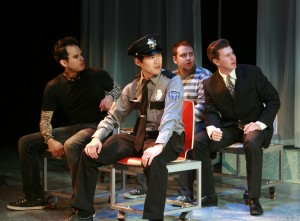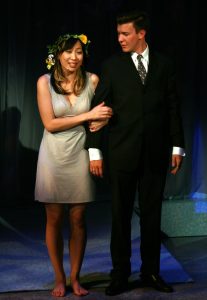Triple Threat Needs Help With John Doe Musical

(from left) Keala Milles, Albert Park, Michael Parrott, and Austin Holden
Production photos by Christina Rogers (xtinaphotog.com)
Being a triple threat in the world of musicals is so hard that it borders on impossible. The skills needed to compose wonderful music are often not the same ones to write catchy lyrics, and even if one can write songs the musical’s book is oftentimes evasive.
So, it is no surprise that Emmy-winning producer Robert Moutal has struggled in his debut as a musical theatre triple threat in creating the world premiere of John Doe, now showing through November 25 at the Lyceum Space Theatre in Horton Plaza.
On the surface John Doe is about a man (Michael Nieto) who ends up in a hospital emergency room with no identification and apparently in a coma. He is cared for by one nurse in particular (Rachel Propst), who takes a liking to him without knowing anything about him. Also hanging about are five fairly stereotypical and one-dimensional men who are not seen by the staff but who watch the goings on from a set of waiting room chairs. A sixth character (Jane Lui), who it turns out, is John’s wife, flits in and out like a mental case, clinging to one or more of the men.
Bit by bit, it comes out that John (we eventually do learn his real name, but I’ll keep calling him John) is a writer and the men are characters representing various parts of his personality that are not well integrated. These parts can be divided into Freud’s id (Keala Milles), ego (Geoffrey A. Cox), and superego (Albert Park) as well as a man overly impressed with himself (Austin Holden) and a man who under-appreciates himself (Michael Parrott).
These five characters might have been interesting ways of examining the facets of an individual struggling to find integration. But, we don’t learn that they are these facets until well along in Act 1. Until then, they are merely five annoying one-dimensional figures, and it is hard to care about any of them.
Even after we learn their actual function, the story never follows through with them. Instead, it becomes diverted toward John’s wife and how she has been trying to murder him to gain control of a book he’s written that looks to make him very rich. Even that plot-line is rather summarily resolved, though, and we end up with John’s sleep-filled “romance” with his nurse as the piece that drives the book forward to its conclusion.
And what happens to the five parts of John? Not much, actually, and it’s maddening to realize that a lot of energy has been invested in characters and a story that go nowhere.
It might help if the songs were memorable or especially insightful. It turns out, though, that the book is the strongest part of the show. The music has a few good melodies, but mostly it’s derivative of a bunch of pop/rock styles whose general feel doesn’t always fit the situation in which the song is performed. The lyrics are perhaps the weakest element: they’re simplistic. Simple can many times be good for advancing the story. Simplistic merely interrupts, and that’s what these lyrics generally do. [php snippet=1]
I’ll give Mr. Moutal credit: he’s given some professional work to a number of young performers and members of the creative team. The performers to a person should be commended for their commitment to material that clearly needs work, but they are inexperienced, and it shows. Michael Schwartz’s direction is slack, and Nadia Lancelot’s scenic design, a series of hospital curtains, was probably as good as could be done with what I’m sure was a limited budget. It did, however, force the cast to work overly close to the audience in a show that needs some distance to be appreciated.
My advice to Mr. Moutal would be to use this run to gauge what works and what doesn’t, then go back and focus the book on one of the story’s threads. I’d also bring in a lyricist for help in the show’s weakest area (note the observation at the top of this review about triple threats – collaboration in musical theatre is almost always a good thing). Probably quite a bit of the show will be rewritten as a result, but, hey, almost all musicals take 7-10 years before they’re really ready. This one’s only been two years in the making so far.
[box] Performs Wednesday and Thursday at 7:30, Fridays at 8, Saturdays at 2 and 8, and Sundays at 2 and 7 at the Lyceum Space Theatre in Horton Plaza. Tickets are priced between $20 and $35. See below for box office phone number and online sales link. The show runs two hours, including one fifteen-minute intermission. It is recommended for ages 13 and up.
DOWNLOAD CAST AND CREDITS HERE[/box]
Click here for a video preview

In addition to reviewing theatre for San Diego Story, Bill also reviews for TalkinBroadway.com. He is a member of the San Diego Theatre Critics Circle and the American Theatre Critics Association. Bill is an emeritus professor in the School of Journalism and Media Studies at San Diego State University.




Hello. Thank you for your preceptive review of John Doe.
I am hoping to become a theatre critic my self and have a few questions though. Why is Michael Schwartz’s directing slack? And what was wring with the design? What would you have done?
Thanks! Tracy
Hi, Tracy. Thanks for your comments. Why don’t you see John Doe and post back here what you agreed and disagreed with my assessment?